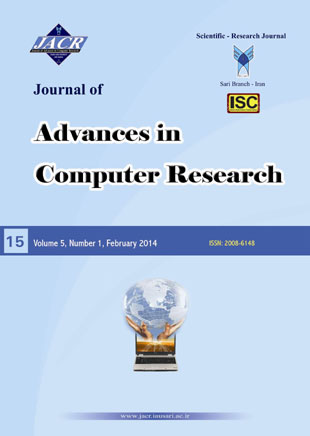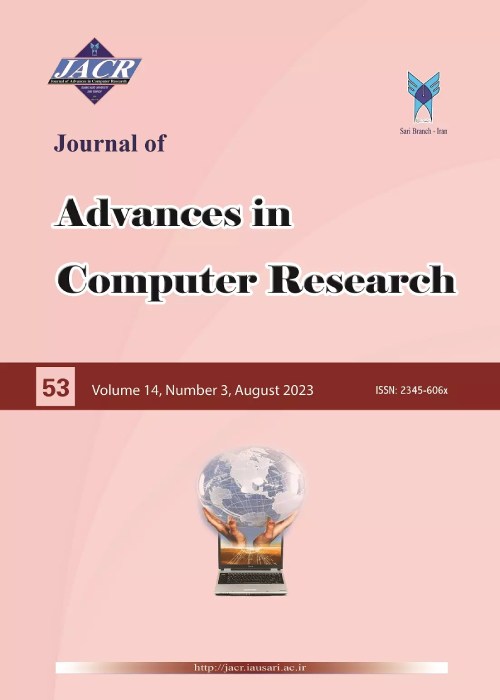فهرست مطالب

Journal of Advances in Computer Research
Volume:5 Issue: 1, Winter 2014
- تاریخ انتشار: 1392/12/14
- تعداد عناوین: 8
-
Pages 1-12Anti-lock Braking System (ABS) is a nonlinear and time varying system including uncertainty, so it cannot be controlled by classic methods. Intelligent methods such as fuzzy controller are used in this area extensively; however traditional fuzzy controller using simple type-1 fuzzy sets may not be robust enough to overcome uncertainties. For this reason an interval type-2 fuzzy controller is developed to improve the performance of ABS in presence of uncertainty such as changing road condition. The output membership functions have been optimized by Discrete Action Reinforcement Learning Automata (DARLA) technique. Simulation results show the effectiveness of the proposed controller in comparison to type-1 fuzzy controller.Keywords: Anti, lock Braking System (ABS), Discrete Action Reinforcement Learning Automata (DARLA), Type, 2 fuzzy controller
-
Pages 13-18Wireless ad hoc networks are composed of independent nodes managing the network without any infrastructure. The connection between nodes is provided by sending packages and by trusting to each other. Therefore, using efficient and certain protocols is the essential requirement of these networks. Due to special characteristics of wireless ad hoc networks such as lack of a fixed infrastructure, these protocols are exposed to many attacks. One of these attacks is black hole attack. In this attack, the node running this attack attracts data packages by sending a false response to source node and destroys them. In this paper, the effect of black hole attack on DSR and AODV routing protocol in wireless ad hoc network has been studied. The results simulated with NS2 simulator software show the weaknesses and advantages of these protocols when there are black hole nodes in the network.Keywords: wireless ad hoc network, black hole attack, AODV protocol, DSR protocol, NS2 simulator
-
Pages 19-28Computer aided pulmonary nodule detection has been among major research topics lately to help for early treatment of lung cancer which is the most lethal kind of cancer worldwide.Some evidence suggests that periodic screening tests with the CT of patients will help in reducing the mortality rate caused by the lung cancer. Acomplete and accurate computer aided diagnosis (CAD) system for detection of nodules in lung CT images consists of three main steps: extraction of lung parenchyma, candidate nodule detection and false positive reduction. While precise segmentation of lung region speed upthe detection process of pulmonary nodules by limiting the search area, in candidate nodule detection step we attempt to include all nodule like structures. However, the main problem in the current CAD systems for nodule detection is the high false positive rate which is mostly associated to misrecognition of juxta-vascular nodules from blood vessels. In this paper we propose an automated method which has all of the three above mentioned steps. Our method attempts to find initial nodules by thresholding and template matching. To separate false positives from nodules we use feature extraction and neural classifier. The proposed method has been evaluated against several images in LIDC database and the results demonstrateimprovements comparing to previous methods.Keywords: False positive reduction, neural classifier, pulmonary nodule detection, template matching
-
Pages 29-42In this paper, a new alternative method for order reduction of high order systems is presented based on optimization of multi objective fitness function by using Harmony Search algorithm. At first, step response of full order system is obtained as a vector, then, a suitable fixed structure considered for model order reduction which order of original system is bigger than fixed structure model. Parameters of model order reduction are determined by minimizing the multi objective fitness function where the fitness function is conducted with integral square error and H∞ norm of error. The harmony search algorithm is applied for minimizing the multi objective fitness function. To assure the stability, the Routh criterion is applied for specifying the stability conditions. This stability condition is considered as constraints in optimization problem. To present the accuracy y of the proposed method, three test systems are reduced. The obtained results show that the proposed approach performs very well.Keywords: Harmony search, model reduction, Routh criterion, H∞ norm, Integral square error
-
Pages 43-51This paper presents a new control scheme for a class of nonlinear systems. In the proposed method, an adaptive neural network observer with Rise feedback controller are applied to realize sensorless control scheme. This observer is tuned online and no exact information of nonlinear term of plant is required. So, this characteristic can compensate mismodeling phenomena. Also, a new controller called Robust Integral of the Sign of the Error (Rise) is considered to realize control purpose. This controller is inspired from 2nd order sliding mode while it can control system with different relative degree. Also, its chattering is acceptable in comparison with sliding mode strategy. This observer based control scheme is considered for modified Duffing chaotic system. The modified Duffing system is derived from Metamorphic shape-changing Underwater autonomous vehicle (MUV). The chaotic behavior of modified Duffing system has a negative impact on MUV performance. Therefore, the controlling of this system can be important. In order to assess the performance of the proposed method, this strategy is compared with observer-based sliding mode control. The comparison results confirm the advantages of proposed method.Keywords: Rise feedback, twisting algorithm, neural network, adaptive observer, nonlinear system
-
Pages 53-60Wireless sensor networks are composed of hundreds or thousands of small nodes called sensor that work together and are associated with a specific task or tasks to do. Each of these nodes includes sensor, processor, communication components, a small memory and a source of energy. It is expected that wireless sensor networks will be used widely in many applications in near future. Scalability and lifetime extension in wireless sensor networks are critical issues in designing and implementing a wireless Sensor Network (WSN).Relay Nodes (RNs) in WSN are nodes with higher useful power and radius, which considered as head of network. RNs are able to disseminate data in a higher level, network clusters, and network regions. In this paper, a novel algorithm is proposed to cover all sensor nodes with the least possible RNs. The number of RNs can be calculated through a proposed mathematical function which has the maximum rate of detection. The proposed approach shows high capability for fault tolerance in WSN when compared to other algorithms.Keywords: Relay Node, Clustering, Fault Tolerance, Wireless Sensor Networks
-
Pages 61-67Because of high speed, efficiency, robustness and flexibility of multi-agent systems, in recent years there has been an increasing interest in the art of these systems. In competitive multi agent systems, a mechanism is required via which the agents can come to reach an agreement. Contract net protocols are one of the well-known negotiation protocols in multi-agent systems. In contract net protocol, each agent can be a manager or a contractor. The managers announce available tasks and the contractors bid over the tasks. Then, the managers investigate received bids and decide which contractor could perform the task. The decision is made based on an eligibility function. In this paper, a multi robot foraging problem is considered where mobile robots with limited energy resource try to transport some moving objects to a collection point. The problem is modeled as a contract net system and then solved. Efficiency of the algorithm and optimality of solutions are investigated by provided examples and simulations.Keywords: Distributed Artificial Intelligence, Multi, agent systems, Contract Net Protocol, Foraging Robots
-
Pages 69-82For last years, the evolution of new issues has incited a great development of the transportation system. In this paper, we discuss ingredients of ITS (intelligent transportation system) that are inter-vehicle communication (IVC) or what can call vehicular ad hoc networks (VANET), which are special type of MANET. We will survey the main issues relevant to VANET in detail with providing a conceptual model for the overall taxonomy. Also detail applications comparison, characteristics and properties of vanet projects and applications are given. Mobility models are benefit to research area, so their main features are discussed. The consortiums relatives of these systems are introduced. Whole protocol type’s classification with their common using protocols is proposed and analysis for the main relative ones provided. Also some suggestions for routing protocols, data diffusion, mobility models, media access control protocols, and security are discussed. The investigation will try to answer to future relative attributes and limitations.Keywords: VANET, ITS, communication, vehicle, security, mobility


